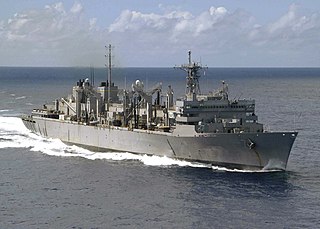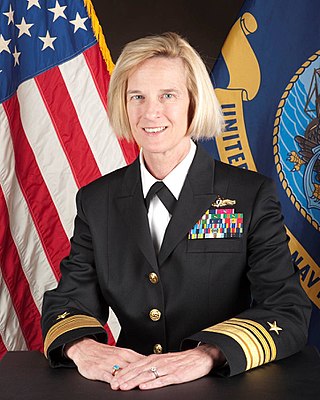
The fast combat support ship is a type of replenishment auxiliary ship. Different from traditional logistic ships, the fast combat support ship is designed with high speed to keep up with the carrier battle group/carrier strike group, while the multi-product station is capable of supplying all types of necessities for the fleet.

The Lewis and Clark class of dry cargo ship is a class of 14 underway replenishment vessels operated by the United States Navy's Military Sealift Command. The ships in the class are named after famous American explorers and pioneers.

Military Sealift Command (MSC) is an organization that controls the replenishment and military transport ships of the United States Navy. Military Sealift Command has the responsibility for providing sealift and ocean transportation for all US military services as well as for other government agencies. It first came into existence on 9 July 1949 when the Military Sea Transportation Service (MSTS) became solely responsible for the Department of Defense's ocean transport needs. The MSTS was renamed the Military Sealift Command in 1970.

Combat stores ships, or storeships, are ships used to store naval supplies. They are used to deliver supplies such as provisions and fuel to combat ships on extended deployments. The United States Navy operated the Sirius and Mars classes and the Royal Navy operated the Fort Rosalie class and continues to operate one Fort Victoria class ship, having scrapped the other. They carried or carry the fleets's refrigerated stores, dry provisions, technical spares, general stores, fleet freight, mail and replacement personnel\specialists. Storeships should not be confused with fast combat support ships which are high speed auxiliary ships or tenders which provide maintenance support to flotillas.

USNS Yukon (T-AO-202) is a Henry J. Kaiser-class underway replenishment oiler operated by the Military Sealift Command to support ships of the United States Navy.

United States Naval Ship (USNS) is the prefix designation given to non-commissioned ships that are property of the United States Navy (USN).

USNS Observation Island (T-AGM-23) was built as the Mariner-class merchant ship Empire State Mariner for the United States Maritime Commission, launched 15 August 1953, and operated by United States Lines upon delivery on 24 February 1954, making voyages for the Military Sea Transportation Service (MSTS) until going into reserve at Mobile, Alabama on 9 November 1954.

USS Flint (AE-32/T-AE-32) is a Kilauea-class ammunition ship of the United States Navy, and was named after the sparking rock flint. Flint was constructed at the Ingalls Nuclear Shipbuilding Division, Litton Industries, Inc., Pascagoula, Mississippi. The ship was delivered to the United States Navy at Charleston, South Carolina, on 30 August 1971.

USNS Mount Baker (T-AE-34) was the seventh of eight Kilauea-class ammunition ships. She served in the United States Navy from 1972 to 1996 and with the Military Sealift Command from 1996 to 2010. She was scrapped in 2012.

USNS Safeguard (T-ARS-50), formerly USS Safeguard (ARS-50), is the lead ship of her class and the second United States Navy ship of that name.
USS LST-546 was a United States Navy LST-542-class tank landing ship in commission from 1944 to sometime between 1946 and 1952. From 1952 until 1972 she served in a non-commissioned status in the Military Sea Transportation Service and Military Sealift Command as USNS LST-546 (T-LST-546).
Rescue and salvage ships are a type of military salvage tug. They are tasked with coming to the aid of stricken vessels. Their general mission capabilities include combat salvage, lifting, towing, retraction of grounded vessels, off-ship firefighting, and manned diving operations. They were common during World War II.

USNS Kilauea (AE-26) was the lead ship of her class of ammunition ships of the United States Navy. She was named for Kilauea, the Hawaiian volcano.

MV Charles L. Gilliland, formerly USNS Gilliland (T-AKR-298), is a Gordon-class roll on roll off vehicle cargo ship of the United States Navy. She was originally built as a merchant vessel but later acquired and converted by the Navy, and assigned to the United States Department of Defense's Military Sealift Command. Gilliland was built in 1972 as MV Selandia. After some time spent in commercial service she was lengthened by Hyundai Heavy Industries in 1984, and later went on to be acquired by the US Navy under a long term charter. She was converted to a US Navy Vehicle Roll-on/Roll-off Ship at Newport News Shipbuilding and Drydock Company in Newport News, Virginia, in a contract dated 23 May 1997 and on completion was assigned to the Military Sealift Command under the name USNS Gilliland, after Medal of Honor recipient Corporal Charles L. Gilliland. Gilliland is one of 28 Strategic Sealift Ships operated by the Military Sealift Command. She was assigned to the MSC Atlantic surge force, and is maintained in Ready Operational Status 4.

Carol M. Pottenger is a retired United States Navy flag officer. She was among the first women to be assigned to serve at sea in 1978, the first female admiral to command a major combat organization, Amphibious Force 7th Fleet/Expeditionary Strike Group Seven, encompassing the amphibious forces assigned to the western Pacific; and the first female admiral to lead a combatant force "type command", Navy Expeditionary Combat Command, charged with the manning, training and equipping of over 40,000 expeditionary sailors in preparation for combat deployments to Iraq and Afghanistan, as well as global security assistance operations. Her final naval post was with NATO as deputy chief of staff for capability and development at Supreme Allied Commander Transformation, Norfolk, Virginia, the first female officer to hold this position.
The Naval Fleet Auxiliary Force is a division of the US Navy. The 42 ships of the Military Sealift Command's Naval Fleet Auxiliary Force are the supply lines to U.S. Navy ships at sea. These ships provide virtually everything that Navy ships need, including fuel, food, ordnance, spare parts, mail and other supplies. NFAF ships enable the Navy fleet to remain at sea, on station and combat ready for extended periods of time. NFAF ships also conduct towing, rescue and salvage operations or serve as floating medical facilities. All NFAF ships are government owned and crewed by civil service mariners. Some of the ships also have a small contingent of Navy personnel aboard for operations support, supply coordination and helicopter operations.













